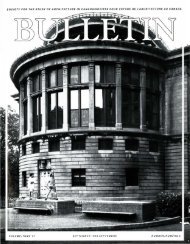CANADA - SEXTONdigital
CANADA - SEXTONdigital
CANADA - SEXTONdigital
Create successful ePaper yourself
Turn your PDF publications into a flip-book with our unique Google optimized e-Paper software.
L ANE BaRSTAD > ESSAY I ESSAI<br />
'<br />
' .t<br />
furnishings, are placed on the floor to the<br />
right and in the space above the musician<br />
floats a group of faint intertwined<br />
figures. By dividing the composition in<br />
half with the dark heavily drawn figure<br />
of the cel list at the bottom and the lightly<br />
drawn cloud of figures at the top, Allward<br />
suggests the division between an earthly<br />
sphere of existence and a heavenly one.<br />
The link between the two is provided by<br />
the upward glance of the player. Allward,<br />
himself a ce ll ist, may be portraying divine<br />
inspiration for the creation of the artsthe<br />
artist and his muses. 45<br />
FIG . 10. WALTER ALLWARD, THE MUSICIAN (BORST AD CATALOGUE #18), 1914.<br />
of public monuments. The drawings have public art. The folly inherent in the pursuit<br />
a dark, ominous, and melancholic quality of earthly pleasure, the passage of time,<br />
that reflects Allward's romantic nature and inevitability of death, personal sacrifice,<br />
show him to have been a private and introspective<br />
individual. They also are marked throughout the balance of his career.<br />
a sense of entrapment, all form themes<br />
by a strong spiritual quality that reappears<br />
in the form of Christian symbols of sacrifice<br />
and resurrection in all of his later a small enclosed space reminiscent of a<br />
In The Musician (fig . 10) a cellist sits in<br />
monument studies. Here are the private jail cell with a high barred w indow to the<br />
emotional struggles that he wove into his left. A sleeping mat and bowl, the only<br />
Like The Musician, the composition of<br />
Death of Artist (fig. 11) is divided into two<br />
realms. The drawing depicts the interior of<br />
an artist's studio with the figure of the artist<br />
lying dead or dying on a bed to the left.<br />
A mourning figure is collapsed across the<br />
artist's body. On the right, is a large painting<br />
of a crucifixion set on an easel. A small<br />
table with palette and brushes is placed<br />
at its base. In the centre of the picture, a<br />
bearded face floats above the scene. The<br />
painting of Christ's death, on the right, parallels<br />
the artist's death, on the left. The position<br />
and identification of the artist's death<br />
with the sacrifice of Christ evokes the image<br />
of the misunderstood and self-sacrificing<br />
artist whose greatness is only recognized<br />
after death. The reference to resurrection<br />
is reinforced by the pale line drawing of a<br />
bearded Christ floating near the painting.<br />
This drawing is the earliest use of overtly<br />
Christian religious symbols which Allward<br />
used extensively in his later designs and<br />
drawings made during World War 11. 46<br />
Another drawing, The Sculptor's Studio (fig.<br />
12), also incorporates re ligious symbolism<br />
in its church-like setting but evokes even<br />
stronger allusions to death. Lying on the<br />
floor is a nude female figure in a cruciform<br />
position. The large wound on her<br />
side reinforces the association with Christ.<br />
Auto-biographical elements are present as<br />
28<br />
JSSAC I JSEAC 33 > N" 1 > 2008
















